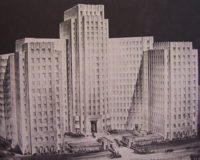A fresh look at the state of historic preservation.
Preservation’s History
And “grandmother” is right, because women constituted many of the first highly visible preservationists. Independence Hall in Philadelphia may be the first nationally important building saved, but The Ladies, with a capital L, of the Mount Vernon Ladies’ Association organized by Ann Pamela Cunningham resolutely raised $200,000 in 1853 to save George Washington’s home, Mount Vernon, Virginia, which had fallen into disrepair by the mid-19th century. Their accomplishments spurred others to action and set a pattern for preserving historic properties.

Today, according to Dennis Pogue, associate director for preservation at Mount Vernon, not enough people are grounded in history, nor do they know much about George Washington—who he was or how he lived. An education center and an orientation center recently added to the property now help tell our first president’s story. In addition, using contemporary archaeology as a guide, Mount Vernon has added a reconstructed slave cabin, as well as a blacksmith’s shop and whisky distillery, all aimed at broadening the view of Washington’s world and increasing its relevance to contemporary audiences. “Our sites, if they hope to be relevant today, need to understand and respond to changes,” Pogue states. Plans are under way for a library, in tune with 21st-century needs for scholarship.
While Mount Vernon remains popular with the public, America’s estimated 8,000 house museums and historic properties in general are experiencing a downward trend in visitors. Ron Bogle, Hon. AIA, who heads the American Architecture Foundation, says that house museums have relied on a model drawn from other museums, a “template that doesn’t make sense anymore.” Bogle cites a “shifting ethic for stewardship” of historic properties, such as the Octagon—a building saved in 1897 by the AIA, housing the oldest architecture and design museum in the U.S., currently maintained by the American Architectural Foundation. Historic properties will need to continually change in order to meet new audiences and find new methods of governance and funding. They require a future vision, Bogle declares, not solely a focus on the past.
Since the mid-19th century, preservation has moved far beyond the house museum. Charleston, South Carolina, and New Orleans (again) count as two cities where preservation jumped in scale from individual property to precinct. In 1931, Charleston initiated a process that resulted in historic district zoning, an action that was followed by the establishment of New Orleans’s Vieux Carré Commission in 1936. Local forces such as the American Institute of Architects backed the movement, which flowered, ultimately, into national legislation: the National Register of Historic Places, the National Trust (1949), and the National Historic Preservation Act (1966).
With the Main Street program, started in the late 1970s, preservation became a community development tool, engaging chambers of commerce, mayors, and community development organizations to preserve historic buildings and districts as a catalyst for urban redevelopment. The program, which has strengthened and enriched neighborhoods across the country, now counts over 1,600 communities among its beneficiaries. Subsequently, preservation escaped its urban boundaries and spread into entire landscapes, preserving the larger natural world in a fight against sprawl, conserving parkland and a more complete understanding of context, urban and rural, all the while engaging more people.




Post a comment to this article
Report Abusive Comment